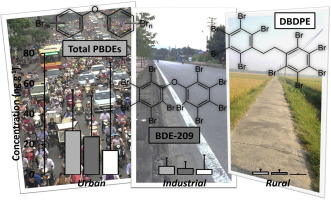Chemosphere ( IF 8.1 ) Pub Date : 2018-01-18 , DOI: 10.1016/j.chemosphere.2018.01.066 Hoang Quoc Anh , Keidai Tomioka , Nguyen Minh Tue , Tran Manh Tri , Tu Binh Minh , Shin Takahashi

|
Polybrominated diphenyl ethers (PBDEs) and selected novel brominated flame retardants (NBFRs) were examined in road dust samples collected from three representative areas in northern Vietnam, including seven inner districts of Hanoi metropolitan area, an industrial park in Thai Nguyen province and a rural commune in Bac Giang province. This study aims to provide basic information on the contamination status, potential sources and human exposure to PBDEs and NBFRs associated with road dust in northern Vietnam. PBDEs were detected in all the samples at a range of 0.91–56 ng g−1 with a median value of 16 ng g−1. PBDE concentrations in road dusts from urban sites were significantly higher than those from industrial zone and rural area, suggesting their environmental load related to urbanization in northern Vietnam. BDE-209, major component of deca-BDE technical mixtures, dominated the congener patterns in all samples, accounting for 60.8–91.9% of total PBDE levels. Decabromodiphenyl ethane, an alternative of deca-BDE, was observed in a detection frequency of 100% in urban and industrial areas and at levels comparable to those of BDE-209. Other NBFRs such as pentabromoethylbenzene, hexabromobiphenyl and 1,2-bis-(2,4,6-tribromophenoxy)ethane, were found at trace levels. Daily intake doses of PBDEs via road dust ingestion from 2.3 × 10−5 to 0.11 ng kg-bw−1 d−1 were estimated for residents in study areas, indicating a negligible risk with hazard indexes of 10−9 to 10−5 for selected congeners such as BDE-47, 99, 153 and 209.
中文翻译:

越南北部道路灰尘中的多溴二苯醚和新型溴化阻燃剂:含量,同类物,排放源及其对人体暴露的影响
在从越南北部三个代表性地区(包括河内市区的七个内区,泰国阮省的一个工业园区和一个农村公社)收集的道路灰尘样品中,对多溴联苯醚(PBDEs)和精选的新型溴化阻燃剂(NBFRs)进行了检查。在北江省。这项研究旨在提供有关越南北部道路尘埃相关的多溴二苯醚和多溴联苯醚的污染状况,潜在来源和人体暴露的基本信息。在所有样品中检测到多溴二苯醚的范围为0.91–56 ng g -1,中值为16 ng g -1。城市地区道路尘埃中的多溴二苯醚浓度明显高于工业区和农村地区,表明其环境负荷与越南北部城市化有关。BDE-209是十溴联苯醚技术混合物的主要成分,在所有样品的同类模式中占主导地位,占多溴联苯醚总量的60.8–91.9%。十溴联苯醚的替代品十溴二苯乙烷在城市和工业区的检出频率为100%,其水平与BDE-209相当。还发现了痕量水平的其他NBFR,例如五溴乙苯,六溴代二苯和1,2-双-(2,4,6-三溴苯氧基)乙烷。每天通过道路尘埃摄入的多溴二苯醚摄入量为2.3×10 -5到0.11 ng kg-bw -1 d对研究区域的居民进行了-1估计,表明对于选定的同类物(如BDE-47、99、153和209),危险指数为10 -9至10 -5,可以忽略不计。











































 京公网安备 11010802027423号
京公网安备 11010802027423号